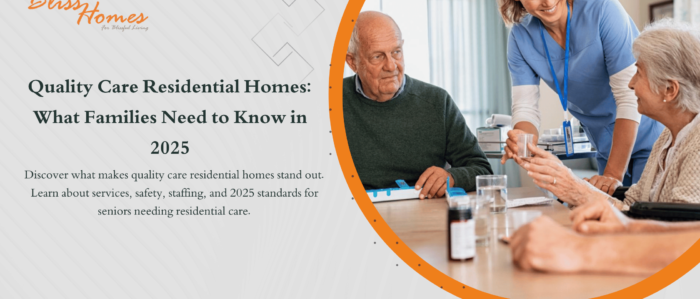Quality Care Residential Homes: What Families Need to Know in 2025

Searching for quality care residential homes can feel overwhelming, especially with so many options and safety concerns in the news. From staffing to safety standards, there’s a lot to consider before trusting a facility with your loved one’s wellbeing.
In California and beyond, many families start their research with options like residential care homes California to ensure their loved ones receive the best support possible.
This 2025 guide will help you understand:
✅ What “quality care” really means in a residential setting
✅ What services these homes offer
✅ Staff training and licensing requirements
✅ How to check for safety and compliance
✅ Newest 2025 senior care trends and data
Let’s dive in and unpack what truly defines a high-quality residential care home.
What Are Quality Care Residential Homes?
Quality care residential homes are licensed community-based facilities that provide seniors or people with disabilities a homelike environment, while offering:
- Personal care assistance (dressing, bathing, grooming)
- Medication management
- Meal preparation
- Housekeeping
- Social activities
- 24/7 supervision
Unlike large nursing homes, residential care homes typically serve a smaller number of residents (often 6–15 people), promoting a family-like atmosphere and more personalized care.
How Are They Different from Assisted Living?
| Feature | Quality Care Residential Homes | Assisted Living Communities |
| Size | Small, usually fewer than 15 residents | Larger, up to hundreds of residents |
| Care Ratio | Higher staff-to-resident ratio | Moderate staff-to-resident ratio |
| Environment | More homelike, intimate | Apartment-style, community-based |
| Services | Basic personal care and supervision | Broader social activities and amenities |
| Cost | Usually $3,500–$6,000/month (2025) | $4,995–$8,000/month depending on amenities |
Residential care homes are perfect for seniors who prefer cozy, personal environments but still need professional help with daily tasks.
2025 Industry Data & Trends
According to SeniorLiving.org, about 1.2 million seniors in the U.S. currently live in small residential care homes. The industry is growing steadily at 4.5% annually, reflecting increased demand for more personalized senior care.
Recent statistics show:
- Average monthly costs range from $3,500 to $6,000 in California.
- About 55% of residential care residents are women.
- The majority are over 80 years old.
Newer trends include:
🟢 Specialized dementia care programs
🟢 Personalized meal plans
🟢 Enhanced staff training on mental health
🟢 Technology for remote health monitoring
Safety and Licensing
One of the biggest factors in quality care residential homes is licensing. All residential care homes should:
✅ Be licensed by state authorities
✅ Undergo regular inspections
✅ Train caregivers in CPR, first aid, and medication safety
✅ Maintain transparent policies
For example, in California, a residential care facility California must meet strict regulations, including fire safety, infection control, and resident rights protections.
You can check licensing through state websites or tools like the Minnesota DHS Licensing Lookup or your local health department’s public records.
Staff Qualifications
Quality residential care homes employ trained caregivers, with many homes also bringing in:
✅ Certified nursing assistants (CNAs)
✅ Medication technicians
✅ Licensed vocational nurses (LVNs)
✅ On-call registered nurses (RNs)
According to Herzing University, staff in these homes generally receive 40–60 hours of initial training, plus continuing education each year to maintain their skills.
What Does “Quality” Really Mean?
A truly quality care residential home goes beyond meeting minimum state standards. Look for homes that offer:
✅ Low staff-to-resident ratios (1:4 or better)
✅ Consistent staff teams, minimizing turnover
✅ Individualized care plans
✅ Family-friendly visitation policies
✅ Meaningful activities tailored to residents’ interests
Reviews, such as those on Caring.com and A Place for Mom, can be extremely helpful in judging reputation. Always tour the home in person, ask to meet caregivers, and check if residents look engaged and happy.
Pros and Cons of Residential Care Homes
Advantages
✅ Homelike environment
✅ Personalized attention
✅ Greater family involvement
✅ Flexible routines
Potential Drawbacks
🚩 Limited on-site medical staff
🚩 Fewer amenities than large senior living communities
🚩 May lack specialized rehab or therapy
If your loved one needs advanced medical care, a skilled nursing facility or hospital may be more appropriate than a residential home.
Questions to Ask When Touring
✔ How many residents do you serve?
✔ What is the staff-to-resident ratio?
✔ Are staff trained in dementia or memory care?
✔ Can families visit anytime?
✔ How are medical emergencies handled?
Facilities like Bliss Homes welcome family tours to answer these questions and show you their quality of care firsthand.
2025 Senior Living Trends
🟢 Telehealth: Widely used for remote check-ups
🟢 Smart home monitoring: Fall sensors and emergency alerts
🟢 Custom care plans: Highly personalized to each resident’s lifestyle
🟢 Green living: Sustainable design and healthy meals
These innovations help residential care homes deliver a safer, healthier experience for seniors who still want a comfortable, homelike setting.
Final Thoughts
Choosing a quality care residential home is one of the most important decisions you’ll ever make for your loved one. While there are many wonderful facilities across the country, doing your homework, asking the right questions, and staying involved will help ensure your family member thrives.
Consider starting your research with local resources, reviews, and even visiting facilities like residential care homes California to see firsthand what high-quality care looks like.
FAQs
Q1: What makes a residential care home “quality”?
Low staff turnover, trained caregivers, personalized attention, and transparent safety standards define a quality care residential home.
Q2: Are residential care homes licensed?
Yes, all reputable residential care homes must be licensed by their state’s health or social services agency.
Q3: How much does a quality residential care home cost?
Typically between $3,500 and $6,000 per month, depending on location and services.
Q4: Do residential care homes provide medical care?
They provide personal care and medication help, but advanced medical treatments usually require a skilled nursing facility.
Q5: What is the difference between a residential care home and a nursing home?
Residential care homes focus on a homelike environment with personal care support, while nursing homes provide 24/7 skilled medical care.
Post navigation
Contact Us
-
Our Location
6149 Coopers Hawk Drive, Jurupa Valley CA 91752
-
Call Us
-
Email Us



